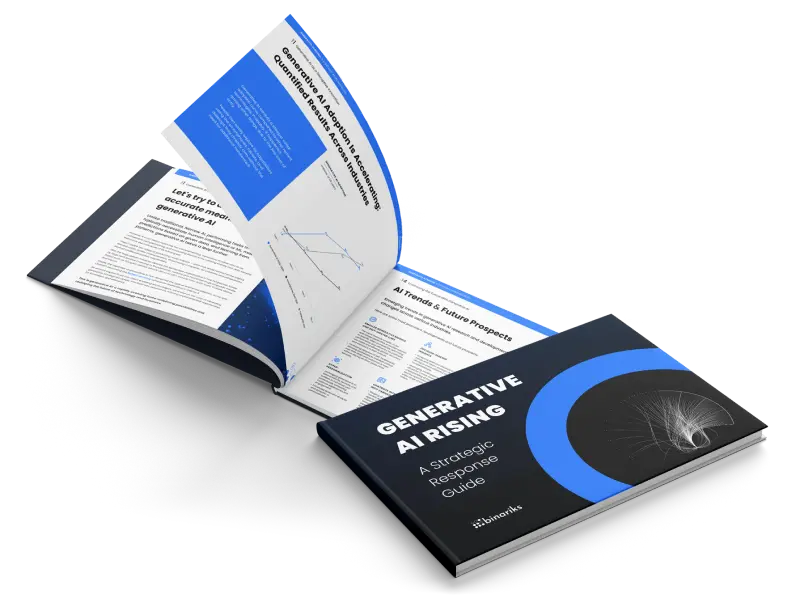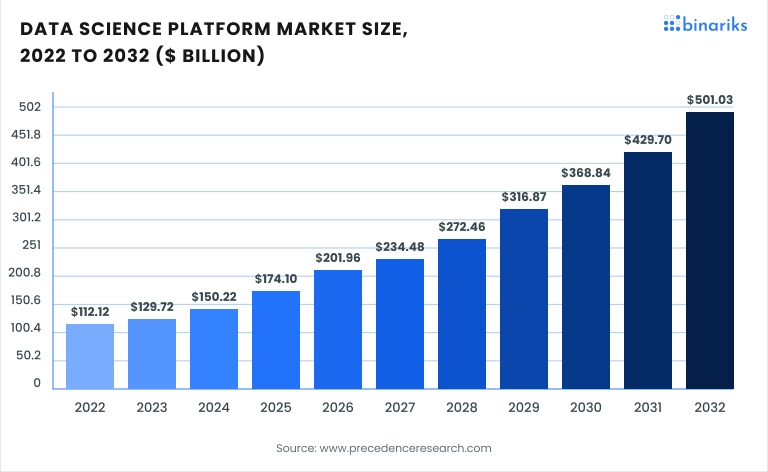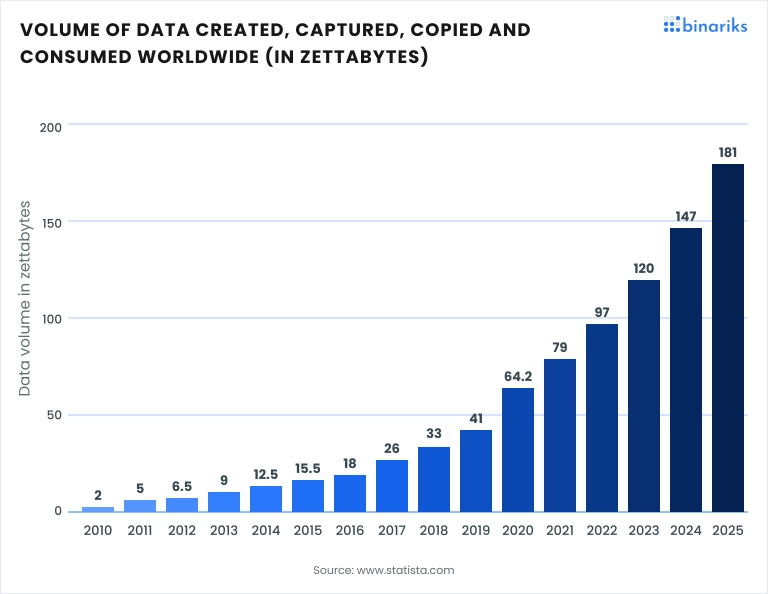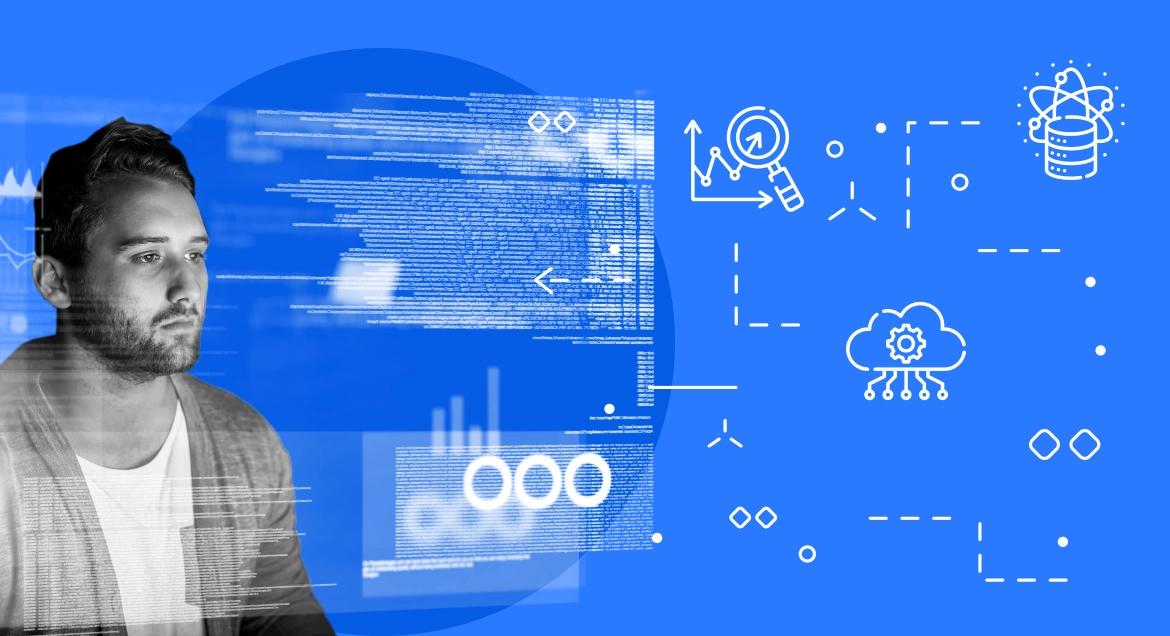You've probably heard it a million times – data is everywhere. But in 2026, that's not just a buzzword. It's a reality you're living every day. Whether you're in healthcare, insurance, banking, or any other data-heavy sector, the challenge isn't collecting information – it's making sense of it. That's where data science steps in.
At Binariks, we work with organizations like yours to turn raw data into real business outcomes. In this article, we'll walk you through the top data science trends in 2026 across industries – what's emerging, what's gaining momentum, and how forward-thinking companies are applying these advances in data science technology to make smarter, faster decisions. You'll get a clear picture of what's next – and how to stay ahead.
Will adopting GenAI mark the next chapter for your business?
Download our free whitepaper now to find out.

Data science technology growth
In 2026, the data landscape is expanding at an unprecedented rate. With 149 zettabytes having been created, captured, and consumed as of 2024, the global volume of data reached 181 zettabytes by the end of 2025. This underscores the critical need for advanced data science solutions to manage and derive meaningful insights from this vast information pool.
The data science platform market is responding robustly to this demand. Valued at 5.15 billion in 2025, it's expected to grow to $676.51 billion by 2034, reflecting a CAGR of 16.2%.

- This growth is mirrored in organizational investments. Approximately 55% of companies claimed to increase their AI data science budgets by 25% or more in 2024, highlighting a strategic shift towards data-driven decision-making.
- The adoption of big data analytics is widespread across various sectors. For instance, 56% of healthcare centers have adopted predictive analysis , with higher rates in some countries like Singapore (92%).
- However, challenges persist. 59% of professionals identify a lack of data science expertise as a primary barrier to fully leveraging AI's potential. This skills gap emphasizes the importance of investing in talent development alongside technological advancements.

9 current trends in data science for 2026
Now, let's move to the top trending topics defining data science in 2026 and the years to come. The nine recent trends in data science that Binariks team has carefully selected to be represented in this article are based on the current state of the market, the landscape of evolving digital technologies , and the demands of consumers.
1. TinyML
TinyML refers to implementing machine learning models on tiny, low-power devices like sensors and IoT (Internet of Things) devices. This trend is significant for edge computing, where data processing occurs close to where it's generated. TinyML is a user-friendly way to process data quickly and competently.
2. Predictive analytics
Want to use data-driven insights for your best benefit? Predictive analytics is your best bet for an impeccable marketing strategy. Predictive analytics highlights the increasing use of machine learning and statistical models to predict future outcomes based on historical data.
For those wanting to anticipate market trends and potential consumer behavior, this is a data science trend to adopt in 2026. Risk assessment also benefited tremendously from predictive analytics .
Predictive analytics relies heavily on the availability of big data. Today, we have more efficient data processing tools capable of handling large volumes of data at incredible speeds, data visualization tools, and cloud computing, which are constantly developing.
3. AutoML
Automated machine learning is one of the new trends in data science. AutoML streamlines and automates the process of applying machine learning models. In this way, it becomes more available to non-experts and more efficient, leading to the democratization of data science.
Essentially, AutoML is ML plus automation and application to real-life problems. With this data science trend, professionals whose primary expertise is not ML have access to ML. The development of ML-based apps heavily relies on automated machine learning.
4. Cloud migration
In 2026, no tool for data storage is more scalable, flexible, and cost-effective than the cloud. Surprisingly, data migration is also quite budget-friendly, as there is no need to invest in additional physical infrastructure.
Therefore, approximately 44% of traditional small businesses utilize cloud infrastructure or hosting services. In contrast, this adoption is higher among small tech companies, with 66% leveraging these services. Enterprises show the highest adoption rate at 74%, and the numbers are only expected to grow.
Right now, the cloud migration market is one of the data science trends that is impossible not to notice. It is currently worth USD 232.51 billion and is projected to grow at a (CAGR) of 28.24% and reach 806.41 billion by 2029.
ABM platform for global manufacturers
We've optimized the app and ensured its migration to the cloud
5. Cloud-native
Cloud-native solutions are designed for cloud-computing environments. They are used to develop services packaged in containers. Unlike cloud migration, which refers to migrating data to the cloud, cloud-native technologies are designed for cloud environments.
Examples of these include microservices, containerization, and dynamic orchestration. Cloud-native technologies are one of the data science trends that participate in scalability and lead to faster development and deployment cycles. They are managed by DevOps technologies. Cloud-native is not some new technology in data science, but this approach is now one of the most popular trends because they are cheaper than building on-premise infrastructure.
6. Augmented consumer interface
This data science trend refers to advanced, data-driven interfaces that enhance user experience through personalization and interactivity. AI and machine learning are both significant tools in creating augmented consumer interfaces.
Moreover, they are prone to using IoT, VR, and AR. These interfaces are expected to transform how we shop and interact, with potential applications in virtual reality shopping experiences and communication interfaces like Brain-Computer Interfaces (BCI).
An example of an augmented consumer interface is a virtual fitting room in an online retail store where customers can create an avatar based on their body measurements and overall looks.
7. Data regulation
In 2026, there is just so much data online that protecting data privacy is the top priority for every business, whatever it might be. This is especially true for data-sensitive domains like healthcare and insurance.
There are several new data regulation acts for new companies to watch for in 2026, including:
- State privacy laws in the USA in states including Montana Consumer Data Privacy Act, Florida Digital Bill of Rights, Texas Data Privacy and Security Act, Oregon Consumer Privacy Act, and Delaware Personal Data Privacy Act.
- In 2024, Canada introduced the Consumer Privacy Protection Act (CPPA), the Personal Information and Data Protection Tribunal Act, and the Artificial Intelligence and Data Act (AIDA). You can expect enhanced individual control over personal data and more substantial penalties for non-compliance from these acts.
- In the EU, an ePrivacy Regulation (ePR) finalized in 2024 establishes regulations on cookie usage and apps like WhatsApp and Facebook Messenger.
- AI regulation entered a pivotal phase in 2024 with the long-awaited AI Act, which will be fully applicable on August 2, 2026 , and is a general EU legislation that adopts a category-based approach to different types of artificial intelligence.
- Digital Services Act (DSA) is an upcoming EU regulation that defines legal and harmful content that can be removed from digital platforms.
Naturally, new legislative acts will persuade businesses to audit their current processes in alignment with the new legislation.
8. AI as a Service (AIaaS)
AI as a service is one of the data science industry trends that allows your company to implement newly emerging AI technologies like OpenAI GPT4 and Google Bard without significant investments. Many of these open-language models make their APIs available to the general public. Businesses can create learning frameworks and chatbots based on the existing language models to cater to their needs.
9. Python's increasing role
Python is the primary programming language for data analytics. If you pursue an engineering job in data science in 2026, this is the language to learn now. Python's role in data science continues to grow due to its versatility and the extensive range of libraries available for data science and machine learning.
Popular examples include Pandas and Scikit-learn. Python is attractive because it is also increasingly used in diverse fields beyond its traditional applications, such as 3D game development and bioinformatics.
Lift your business to new heights with Binariks' AI, ML, and Data Science services
What do experts say about new data science technologies?
In recent years, data science has undergone a dramatic shift. What was once a siloed analytical practice is now deeply embedded in enterprise transformation.
The rise of AI, especially generative and agentic systems, has pushed data science into the spotlight like never before. But with that attention comes confusion. Where exactly is this field heading? And how should organizations – and data scientists themselves – adapt?
To understand where data science is going in 2026 and beyond, it's essential to hear from those shaping its direction. Here's what respected thought leaders say about the recent developments in data science – and what it means for your organization.
From tools to autonomous agents
We're no longer just building tools. We're building agents – intelligent systems capable of acting autonomously and collaborating with other systems to achieve goals. This shift, often referred to as Agentic AI, is one of the most talked-about trends among technology leaders.
As Thomas H. Davenport , a renowned analytics professor, and Randy Bean , a data leadership adviser, discuss the emergence of agentic AI in their article:
"Agentic AI seems to be on an inevitable rise: Everybody in the tech vendor and analyst worlds is excited about the prospect of having AI programs collaborate to do real work instead of just generating content, even though nobody is entirely sure how it will all work."
The excitement is palpable, but so is the uncertainty. There's no shortage of powerful models. What's missing, for many, is a roadmap for how to apply them in ways that truly drive business outcomes. And that's the paradox: the more advanced AI becomes, the more it exposes the underlying complexity of the data science ecosystem.
AI is not a shortcut – it's a system
While many hoped AI would offer a shortcut to better results, it's becoming clear that AI isn't a shortcut – it's a system. A powerful one, yes, but only as effective as the infrastructure, processes, and data it's built on.
This is where the real shift is happening. As Bernard Marr , world-renowned futurist, board advisor, and author, explains:
"The focus will shift from model optimization to data quality as organizations recognize that better data, not just better algorithms, is the key to superior AI performance."
The implications are significant. Organizations leading the AI race are those investing in data governance, operational integration, and cross-functional alignment, not just in hiring more data scientists or experimenting with the latest LLM APIs.
That brings us to the human question: What happens to the data scientist in this evolving landscape?
So, what happens to the data scientist?
As AI takes over many once-core tasks – data visualization, predictive modeling, even code generation – some fear the data scientist role is becoming obsolete. But automation doesn't mean elimination. The role is being reshaped, not erased. The real value is shifting away from execution and toward insight, oversight, and integration.
Chris Mattmann , Chief Technology and Innovation Officer at NASA's Jet Propulsion Laboratory, speaks candidly about this transition:
"Data analysis will be replaced in the next five to 10 years, done better by AI than humans. But training new AI and refining data will still have a big place(...).
AI is data-hungry for fuel, and understanding math, statistics, and how to evaluate data science and AI will be much more important than building it."
His message is clear: the future of data science belongs not to those who simply build models, but to those who understand where and why to apply them. Domain expertise, ethical reasoning, and contextual storytelling are emerging as the most irreplaceable skills. As Mattmann emphasizes, it's also about building supportive networks and adapting to AI's new demands with strategic focus and scientific discipline.
As AI systems grow more autonomous and the ecosystem becomes more complex, data science evolves into a cross-functional discipline tightly integrated with business strategy. The next frontier is smarter systems, built with purpose, refined by data, and guided by context.
At Binariks, we recognize this shift. Our Center of Excellence unites engineers, data scientists, solution architects, and domain experts to transform new data technology into scalable, business-aligned solutions. It's not just about staying current. It's about staying ahead.
What data science trends will be widespread across industries?
Aside from the data science future trends that will undeniably rule most industries, some trends are more industry-specific than those due to their specific benefits. Let's focus on the benefits for the domains in which Binariks has immaculate experience.
Medtech
In medicine, the most critical aspect is to make professionals benefit from the technology and make it a tool that assists them in decision-making and makes everything more accurate and fast. However, this is a hanging balance for stakeholders to maintain, as doctors and caretakers should not over-rely on technology.
1. Data democratization is one of the emerging trends in data science that caters explicitly to medical technology simply because medical establishments have medical and non-medical staff who must be educated about technological advancements for everything to work. Knowledgeable doctors and nurses enhance patient care through informed decision-making.
Example: Large frontrunner companies like Philips and Siemens Healthineers use data science to improve diagnostic tools and patient care. Third-party companies like Tata Consultancy Services (TCS) assist medical companies in making healthcare data accessible.
2. Explainable artificial intelligence (XAI) is a type of AI in which humans get to keep intellectual oversight over their output. Unlike a traditional AI, XAI helps pinpoint where and how a model might go wrong or where biases exist. In MedTech, these types of AI can and will assist in treatment and decision-planning. More effective time spent on diagnosing means more time for actual treatment and room for patient satisfaction and better outcomes.
Example: IBM Watson Health uses XAI in the decision-making process.
Insurtech
Insurance as a sector moves towards faster detection of issues and automatizing some basic human interactions so that professionals can focus on more comprehensive tasks.
1. Data unification. Consolidating data from various sources helps insurance companies assess risk and process claims better. It is also a step towards reconciliation.
Example: Companies like Progressive and Allstate use data unification for personalized insurance premiums and fraud detection.
2. Graph analytics are used to detect fraud patterns and understand customer networks to tailor insurance products.
Example: Large financial institutions used graph analytics for fraud detection and risk assessment.
3. Large language models (LLMs) transform customer service and claims processing by automating interactions and analyzing customer feedback more effectively. They can also help with fraud detection and risk assessment.
Example: Most large banks now use large language models, including JPMorgan Chase and Bank of America.
Fintech
The latest trends in data science mainly focus on processing large amounts of data.
1. Data-driven consumer experience. Banks increasingly use AI to personalize banking experiences . For instance, they recommend financial products or advise on investments .
Example: Banks like Wells Fargo and Bank of America use data-driven consumer experience in their expertise.
2. Adversarial machine learning (AML) is a relatively new field in AI that focuses on the security aspects of machine learning systems. This is especially useful in areas like fraud detection and algorithmic trading.
Example: JPMorgan Chase employs adversarial machine learning to safeguard its AI systems.
3. Data fabric is one of the data analytics trends that is an architecture and set of services that provide consistent data management across various environments. Managing and analyzing large, complex datasets is vital for banks to gain real-time insights for better decision-making and risk management.
Example: Large banks like Citibank or HSBC use data from different sources and integrate it into a cohesive platform. Such data includes transaction records, customer interactions, and market analytics.
Conclusion
As data volumes continue to grow and AI becomes deeply integrated into core operations, it's clear that innovations in data science are no longer optional – they're foundational to business success. The data science technology trends mentioned in this article, from agentic AI to explainable models and scalable cloud-native solutions, are already transforming how organizations make decisions, serve customers, and stay competitive.
Yet adopting these technologies requires more than technical execution. It takes strategic focus, domain expertise, and the ability to translate data into real business outcomes.
At Binariks, we bring this holistic approach to every engagement, supporting you across the full lifecycle – from business analysis and AI solution planning to data preparation, ML modeling, and integration. We also ensure quality assurance and ongoing support, so your AI initiatives deliver measurable impact with clarity, speed, and confidence.
Our AI Center of Excellence unites engineers, data scientists, solution architects, and industry experts to turn emerging technologies into scalable, secure, and business-aligned solutions.
The future of data isn't just big—it's smart. Let's build it together.
Share

